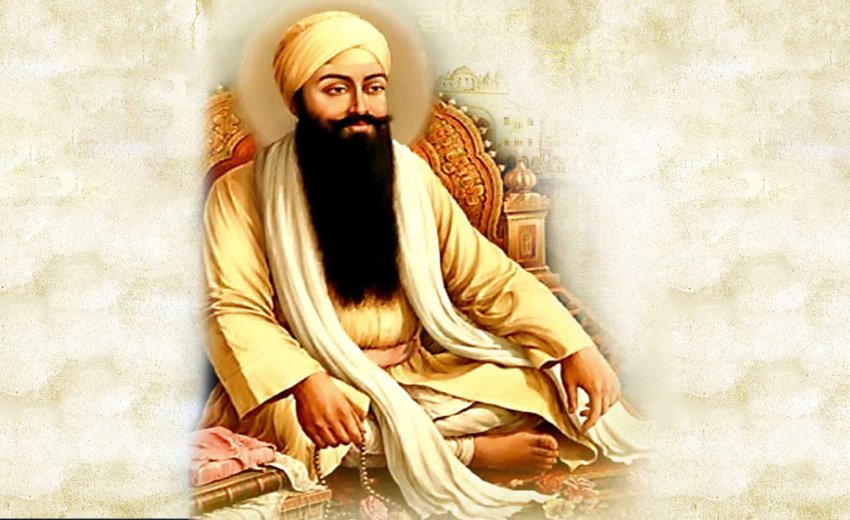On a warm day in Amritsar, the sun cast a clear light over the city, illuminating the minarets of the Akal Takht and the walls of the Golden Temple complex. The streets were bustling with pilgrims who had come to celebrate the birth of the fourth Sikh guru, Guru Ram Das Ji. Moving through the crowd felt like navigating through a rushing sea of people, with the heat adding to the challenge. Despite the warmth, the atmosphere was vibrant and filled with reverence for the occasion.
Guru Ram Das Ji
Guru Ram Das Ji inspired by his Guru's vision, Amar Das built Amritsar from the ground up. The pool around which the city would be built dates back in legend to the bathing and meditation place of Lord Krishna. Guru Nanak Dev's travels seemed to crisscross the place and Guru Ram Das Ji would be the one to plan the area for development.
He envisioned Amritsar as a safe haven for all, where weary travelers could find solace and healing. Drawing on his knowledge of Ayurveda, he filled the area around a sacred pool with medicinal gardens and rest houses (dharamsalas). This transformed Amritsar from a spiritual center into a flourishing community built on compassion and care.
Building the Golden Temple
Guru Ram Das Ji, in Sikh tradition, is credited for founding and constructing the city of Amritsar. The stories surrounding the land's acquisition where Guru Ram Das Ji settled diverge into two versions. According to a Gazetteer record, the land was procured for 700 rupees through Sikh donations from the owners of the village of Tung.
In Sikh historical records, however, it's recounted that the site was selected by Guru Amar Das Ji and named Guru Da Chakk. Guru Amar Das Ji instructed Guru Ram Das Ji to locate land for establishing a new town centered around a man-made pool. Following his coronation in 1574, despite facing opposition from Guru Amar Das Ji's sons, Guru Ram Das Ji initiated the construction of the town, which he named "Ramdaspur" after himself. He commenced the endeavor by completing the pool and erecting his new official Guru center and residence adjacent to it.
In the early days, he welcomed merchants and artisans from different parts of India to join him in the new town. Together, they built and expanded it over time, especially during Guru Arjan's leadership. The growth of the town eventually transformed it into the bustling city of Amritsar. Under Guru Arjan's son's guidance, the town's pool area evolved into a significant temple complex. In 1604, the Gurdwara Harmandir Sahib was constructed, becoming a focal point for Sikhism as the scripture was installed inside.
The period from 1574 to 1604 saw significant construction activity, chronicled in the Mahima Prakash Vartak. This text, likely penned in 1741, is one of the earliest accounts detailing the lives of all ten Gurus. Following the directives of his predecessor, Guru Ram Das Ji oversaw the construction of two man-made pools of holy water, named Ramdas Sarovar and Amritsar Sarovar, in Guru-Da-Chak.
The legacy lives on
Centuries have passed, yet the legacy goes on. Here, anyone can find solace with a hot meal and affordable shelter. Pilgrims flock to absorb the Guru's poetry, extend service to others, and find respite. The commemoration of his birth sets Amritsar ablaze with festivity unlike any other day.
Walking through the streets encircling the complex feels like being swept away in a vibrant river. People diligently distribute food, music fills the air, and every corner of Amritsar resonates with the spirit of the Nagar Kirtan—a grand parade featuring Gurbani Kirtan, gatka displays, and abundant food. It's a delightful sensory overload as crowds gather along the thoroughfares, exchanging sweets and warm smiles amidst the revelry.
At night, the Harimandir shines impressively with white lights adorning every building and dome. The atmosphere outside the complex is vibrant with the sound of Raag Darbar echoing from Manji Sahib. Renowned musicians such as Bhai Balbir Singh and the Jatha of Bhai Dilbag and Gulbag enrich the ambience with classical Indian music, interpreting the Guru's bani with deep emotion. Through soulful alaps and spirited taans, they convey themes of longing, love, and courage present in each poem.
As the Darbar winds down, bright white fireworks illuminate the Harimandir's surroundings, mirroring the brilliance of the lights below. The spectacle reflects both above and below, with the lights shimmering in the pool and bursting in the sky. Pilgrims marvel at the sight, their eyes gleaming with light as they chant "Sat Sri Akal" into the air, invoking the memory of Guru Ram Das Ji, the Lord of Miracles, whose presence seems to shine like the fireworks above.
*Based on an article by Shabd Singh Khalsa, published in Sikh Dharma Worldwide on 10th December 2012
